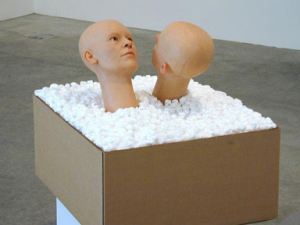In Ken Feingold’s If/Then (2001), two talking robotic heads are nestled in packing peanuts in a cardboard shipping box. Complete with voice-synthesizers and motors that synchronize their mouth movements, they engage in a spoken philosophical discussion on the meaning of life. Drawing on natural language artificial intelligence research, such as Liza, the famous computer program that emulated a psychotherapist, the conversation between the two bots is internally coherent but also very limited. In theory the conversation could go on infinitely without anything of lasting value being communicated, though one might say the same of many exchanges between human beings. Nonetheless, Feingold’s latter-day Galatea’s ironically propose a future in which angst-ridden machine intelligences will wax poetic about their silicon navel lint.[1]
“Two identical heads, sculpted in the likeness of an imaginary androgynous figure, speak to each other, doubting the reality of their own existence. These two, in ever-changing and outrageous conversations with each other struggle to determine if they really exist or not, if they are the same person or not, and if they will ever know. Ken Feingold wanted them to look like replacement parts being shipped from the factory that had suddenly gotten up and begun a kind of existential dialogue right there on the assembly line. Their conversations are generated in real time, utilizing speech recognition, natural language processing, conversation/personality algorithms, and text-to-speech software. They draw visitors into their endless, twisting debate over whether this self-awareness and the seemingly illusory nature of their own existence can ever be really understood.” – Ken Feingold[1]
Feingold has treated the question of communication between humans, between humans and non-humans, and between non-humans in a diverse body of work. Another fascinating example is The Animal, Vegetable, Mineralness of Everything


[1] Edward A. Shanken, Art and Electronic Media. Phaidon, 2009.
[2] Ken Feingold, http://www.kenfeingold.com/catalog_html/ifthen.html
